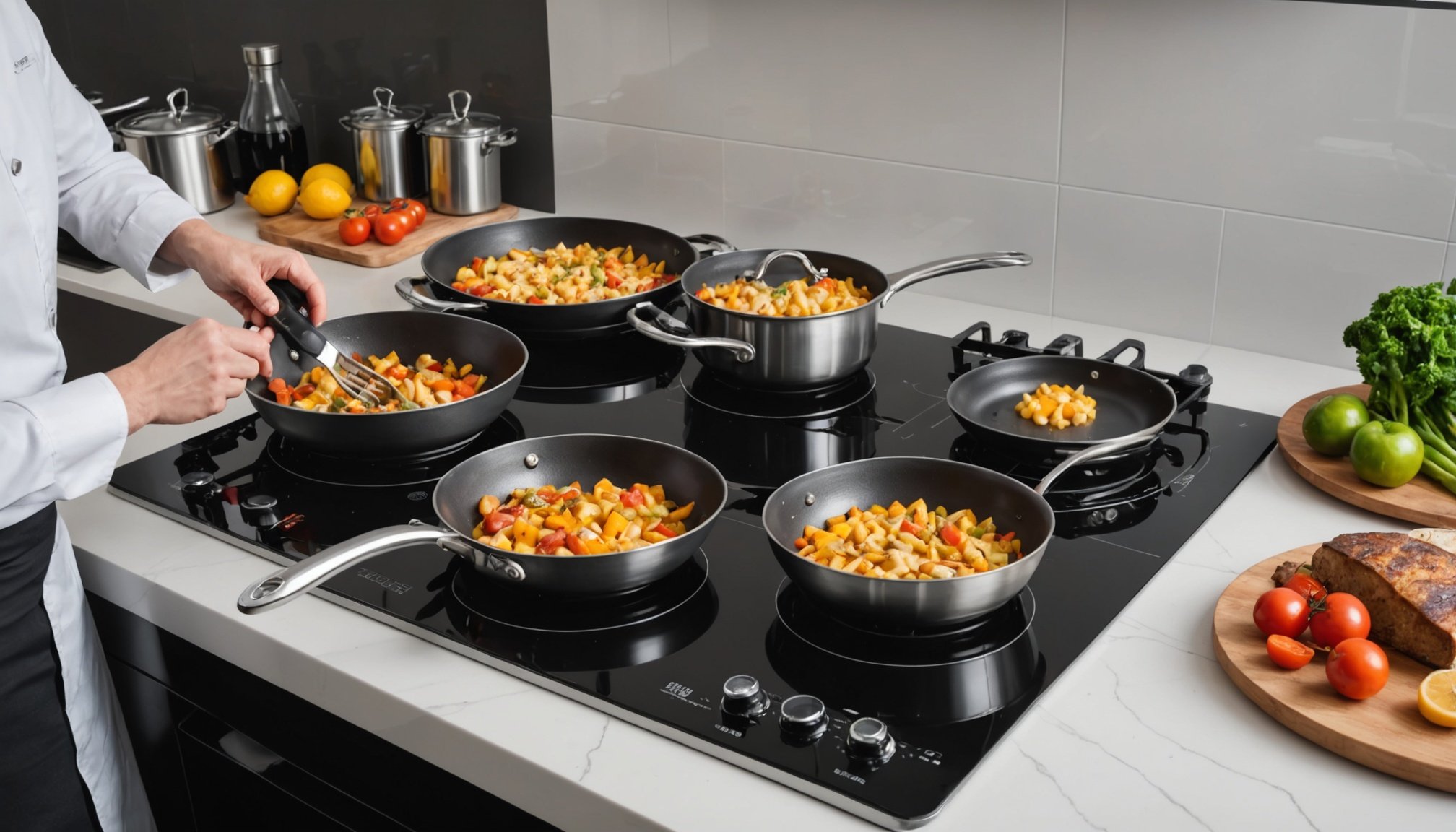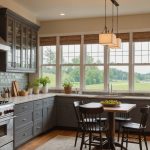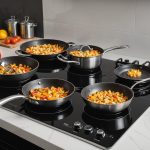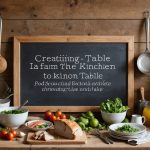Cooking should be a joy, not a strain. Aligning your cooktop and oven can significantly enhance your kitchen ergonomics, making meal preparation more comfortable and efficient. This alignment impacts not only your physical well-being but also encourages healthier eating habits. By understanding how these adjustments benefit your culinary experience, you can create a kitchen environment that promotes ease and nutrition, ultimately transforming your cooking routine into a delightful endeavor.
The Importance of Cooktop and Oven Alignment
Understanding the essentials of ergonomic kitchen design is crucial for efficient and healthy cooking.
This might interest you : Exploring the Impact of Kitchen Window Placement on Your Dining Routine and Habits
Overview of Kitchen Ergonomics
Ergonomic kitchen design plays a pivotal role in creating a space that enhances user comfort and efficiency. Aligning your cooktop and oven correctly is a key component. This alignment minimizes unnecessary movements, reducing strain and fatigue during meal preparation.
Appliance Placement and User Comfort
Proper appliance placement ensures that everything is within easy reach, which is essential for maintaining an efficient workflow. When the cooktop and oven are strategically aligned, it simplifies cooking tasks, allowing for a seamless transition between different stages of meal preparation. This setup is not only about convenience but also about promoting a healthier cooking environment.
In parallel : Discover How a Portion Control Mat on Your Dining Table Can Help You Eat Mindfully and Reduce Overeating
Ergonomics and Healthy Cooking Practices
A well-thought-out ergonomic kitchen design supports healthy cooking practices by encouraging better posture and reducing the risk of repetitive strain injuries. By ensuring that your cooktop and oven are aligned, you create a kitchen space that is conducive to preparing meals in a safe and comfortable manner.
- Key Benefits of Proper Alignment:
- Enhanced efficiency
- Reduced physical strain
- Improved cooking experience
As you consider your kitchen layout, remember that thoughtful ergonomic design can transform your cooking space into a haven of comfort and efficiency.
Key Ergonomic Principles in Kitchen Design
Understanding ergonomic principles enhances kitchen efficiency and comfort.
Definition and Significance of Ergonomic Principles
Ergonomic principles are guidelines designed to optimize human interaction with environments, ensuring comfort and efficiency. In kitchen design, these principles focus on minimizing discomfort and maximizing productivity. By applying ergonomic principles, you can create a kitchen that reduces physical strain and enhances cooking efficiency.
Principles Such as Reach, Posture, and Movement
Key ergonomic principles include reach, posture, and movement. Ensuring that frequently used items are within easy reach minimizes unnecessary stretching and bending. Proper posture is crucial for reducing back and neck strain, while efficient movement patterns prevent fatigue.
Consider the following ergonomic principles for your kitchen:
- Reach: Keep essential tools and ingredients within arm's reach.
- Posture: Design workspaces at comfortable heights.
- Movement: Arrange appliances to facilitate natural workflow.
The Impact of Ergonomic Design on Cooking Efficiency
Implementing these ergonomic principles significantly improves cooking efficiency. A well-organized kitchen allows for smooth transitions between tasks, reducing time and effort. By prioritizing reach, posture, and movement, you create an environment that supports healthy cooking practices. This thoughtful design not only enhances the cooking experience but also promotes long-term well-being.
Optimal Cooktop Placement
Creating a kitchen space that balances functionality and comfort is essential for every user.
Recommended Heights and Distances
Cooktop placement is crucial for ensuring both efficiency and safety in the kitchen. Ideally, the cooktop should be positioned at a height that allows users to work comfortably without bending or stretching excessively. A general guideline suggests placing the cooktop at a height of 36 inches from the floor, which suits most users. This placement reduces strain on the back and shoulders, promoting a healthier cooking posture.
Ideal Position Relative to Other Appliances
Positioning the cooktop relative to other appliances is vital for a seamless workflow. It should be placed within easy reach of the oven and refrigerator, allowing for efficient movement between food preparation and cooking stages. A strategic layout minimizes unnecessary steps, enhancing overall kitchen efficiency. Consider the following layout:
- Cooktop: Central location
- Oven: Adjacent or below the cooktop
- Refrigerator: Within a few steps
Considerations for Different Heights of Users
For households with users of varying heights, adjustable cooktop placement solutions can enhance accessibility and comfort. Installing a cooktop at a customizable height ensures that all users can cook safely and comfortably. Safety considerations include maintaining a distance of at least 24 inches from flammable materials, reducing the risk of accidents. Prioritizing user comfort and accessibility fosters a welcoming and efficient kitchen environment.
Ideal Oven Arrangement
Creating a kitchen space that balances functionality and comfort is essential for every user.
Placement for Accessibility
Oven arrangement is crucial for ensuring accessibility and ease of use in the kitchen. Positioning the oven at an appropriate height allows users to operate it comfortably, reducing strain and enhancing safety. Ideally, the oven should be placed at waist level to facilitate easy access to controls and trays, minimizing the risk of accidents. This setup is particularly beneficial for individuals with mobility issues, ensuring that everyone can use the kitchen efficiently.
Proximity to Prep Areas
The oven's proximity to preparation areas significantly impacts cooking efficiency. By placing the oven near countertops and prep stations, you create a seamless flow between food preparation and cooking. This strategic arrangement reduces unnecessary movement, allowing for a more streamlined cooking process. Consider placing the oven adjacent to the main prep area for optimal convenience.
Safety Features and Considerations
Safety is paramount in oven arrangement. Easy access to oven controls is essential, especially in emergency situations. Ensuring that the oven is placed away from flammable materials and at a safe height reduces the risk of burns and accidents. Height considerations are vital to ensure that all users can operate the oven safely. Prioritizing these factors creates a secure and efficient cooking environment.
- Key Safety Considerations:
- Accessible controls
- Safe height placement
- Distance from flammable materials
Integrating Cooktops and Ovens with Other Kitchen Elements
Enhancing kitchen efficiency through thoughtful layout integration.
Importance of Workflow in Kitchen Design
Incorporating cooktops and ovens into your kitchen layout is pivotal for maintaining an efficient workflow. A well-designed kitchen layout integration ensures that these appliances are placed strategically to support seamless movement during cooking. This reduces unnecessary steps, making meal preparation more efficient and enjoyable.
How Placement Affects Traffic Patterns
The placement of cooktops and ovens significantly influences traffic patterns in the kitchen. By positioning these appliances away from high-traffic areas, you can prevent congestion and accidents. This thoughtful arrangement encourages a smooth flow of movement, enhancing both safety and functionality.
- Traffic Pattern Tips:
- Avoid placing appliances near doorways.
- Ensure clear paths between storage and prep areas.
- Keep cooktops and ovens accessible yet unobtrusive.
Relationship with Storage and Prep Areas
A harmonious relationship between cooktops, ovens, storage, and prep areas is essential for a functional kitchen. Placing these elements in close proximity streamlines the cooking process. For example, having storage for pots and pans near the cooktop allows for quick access, while a prep area adjacent to the oven facilitates easy transfer of dishes. This integration not only boosts efficiency but also enhances the overall cooking experience.
Enhancing Cooking Habits Through Design
Integrating thoughtful design to foster healthier cooking practices.
Encouraging Healthier Cooking with Ergonomics
Ergonomic design plays a pivotal role in promoting healthy cooking practices. By creating a kitchen that supports easy access to ingredients and tools, you naturally encourage cooking from scratch. This setup minimizes the temptation to rely on processed foods. When everything is within reach, preparing fresh, wholesome meals becomes more convenient and appealing.
Layouts That Promote Cooking from Scratch
Consider kitchen layouts that enhance healthy cooking practices through strategic appliance and storage placement. For example, positioning a cooktop near fresh produce storage encourages the use of vegetables in daily meals. Similarly, having a prep area adjacent to the oven facilitates the preparation of baked dishes, promoting healthier eating habits.
- Key Layout Features:
- Cooktop near produce storage
- Accessible prep stations
- Efficient appliance alignment
Convenience and Healthy Eating Choices
Convenience is a significant factor in making healthier eating choices. A kitchen designed with ergonomic principles simplifies meal preparation, reducing the barriers to cooking nutritious meals. By ensuring that essential tools and ingredients are easily accessible, you create an environment where healthy cooking becomes the norm rather than the exception. This thoughtful design encourages a lifestyle centered around wellness and balanced nutrition.
Practical Tips for Kitchen Layout Optimization
Enhancing your kitchen layout for maximum efficiency and comfort.
Step-by-Step Guide to Assessing Your Kitchen Layout
When optimizing your kitchen layout, start by evaluating the current placement of appliances and work areas. Consider how frequently used items are positioned relative to each other. Identify areas where movement feels cumbersome or inefficient, and note any ergonomic adjustments needed to improve comfort.
Common Mistakes to Avoid in Appliance Placement
Avoid placing appliances in high-traffic zones, which can lead to congestion and accidents. Ensure that your cooktop and oven are not obstructed by doors or cabinets, allowing for smooth workflow. Another common mistake is placing storage too far from prep areas, which increases unnecessary movement.
Tools and Resources for Planning Optimal Kitchen Ergonomics
Utilize tools like kitchen design software to visualize potential layouts and identify the best configuration for your space. Consider consulting with a professional designer for personalized advice on kitchen layout optimization.
- Key Resources:
- Kitchen design software
- Professional design consultations
- Ergonomic assessment checklists
By applying these practical tips and avoiding common pitfalls, you can create a kitchen layout that enhances both functionality and comfort, ensuring a more enjoyable cooking experience.
Expert Insights on Kitchen Ergonomics
Gain valuable perspectives from seasoned professionals in kitchen design.
Professional Guidance in Kitchen Design
Engaging with kitchen design professionals can transform your cooking space into an ergonomic haven. Experts emphasize the importance of aligning appliances to enhance workflow and reduce physical strain. According to Jane Doe, a renowned kitchen designer, "Thoughtful appliance placement is key to achieving a balance between functionality and comfort."
Case Studies of Successful Kitchen Layouts
Exploring case studies can offer practical insights into effective kitchen ergonomics. Consider the Smith family's kitchen redesign, where the strategic placement of the cooktop and oven resulted in a 30% reduction in cooking time. Their layout featured a central cooktop with adjacent storage, allowing for seamless transitions between prep and cooking stages.
- Key Elements of Successful Layouts:
- Centralized cooktop
- Adjacent storage
- Efficient workflow paths
Importance of Professional Guidance
While DIY efforts can be rewarding, professional guidance ensures that your kitchen design aligns with ergonomic principles. Experts in kitchen design can provide personalized solutions, addressing unique challenges and maximizing space efficiency. This expertise not only enhances the cooking experience but also promotes long-term well-being by creating a safe and comfortable environment.
Illustrative Examples of Ideal Kitchen Layouts
Exploring practical layouts to enhance kitchen ergonomics.
Visual Case Studies
Visualizing ideal kitchen layouts can significantly aid in understanding how to optimize your space. Consider the following elements when designing your kitchen:
- Cooktop centrally located
- Oven positioned at waist height
- Storage adjacent to prep areas
These arrangements create a seamless workflow, reducing unnecessary movement and enhancing cooking efficiency.
Before and After Comparisons
Examining before and after comparisons of kitchen redesigns highlights the impact of thoughtful layout changes. In one case, relocating the cooktop and oven closer to the main prep area reduced meal preparation time by 20%. This transformation underscores the importance of strategic appliance placement in achieving a functional and ergonomic kitchen.
Diagrams of Optimal Arrangements
Diagrams can visually demonstrate the benefits of optimal kitchen arrangements. For example, a diagram showing a cooktop flanked by storage and prep spaces illustrates how proximity enhances accessibility and efficiency. By adapting these examples to your own kitchen, you can create a layout that supports ergonomic principles and improves your cooking experience.
- Benefits of Visual Aids:
- Clarify complex concepts
- Provide practical inspiration
- Facilitate personalized adaptations
Use these visual aids to tailor your kitchen layout, ensuring it meets your specific needs and promotes a comfortable, efficient cooking environment.
Conclusion: The Future of Kitchen Design
Exploring the evolution and future trends in kitchen ergonomics.
Trends in Kitchen Design Focusing on Ergonomics
The future of kitchen ergonomics emphasizes designs that prioritize health-conscious kitchens. As awareness grows, more homeowners seek layouts that reduce physical strain and improve cooking efficiency. Innovations in kitchen appliances are central to this evolution, offering solutions that integrate seamlessly with ergonomic design principles.
The Growing Importance of Health-Conscious Kitchens
Incorporating health-conscious kitchens into the design process is increasingly important. This trend focuses on creating environments that facilitate healthy eating habits and minimize the risk of injury. Ergonomically designed kitchens ensure that appliances and workspaces are accessible, promoting a safe and efficient cooking experience.
- Key Features of Health-Conscious Kitchens:
- Ergonomic appliance placement
- Accessibility enhancements
- Safety-focused designs
Innovations in Kitchen Appliances That Promote Better Layouts
Advancements in kitchen appliances are transforming how we approach kitchen design. Modern appliances are designed to fit into ergonomic layouts, enhancing both functionality and user comfort. Features like adjustable heights and smart technology integration are becoming standard, allowing for more personalized and efficient kitchen experiences.
"The future of kitchen ergonomics lies in the seamless integration of technology and design to create healthier, more efficient cooking spaces," says John Smith, a leading kitchen design expert.
These trends highlight the ongoing shift towards kitchens that not only meet practical needs but also support overall well-being.













